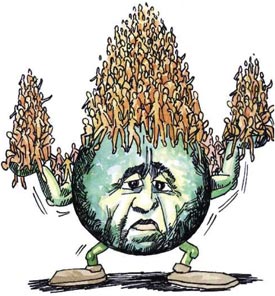It has been 20 years since the first Earth Summit in Rio, and the next one, the Rio+20 Conference, is about to occur, June 22-24. Government delegates from all over the world will be talking about findings from an analysis done by a group of international scientists that just came out. But the findings deserve all of our attention. The scientists report that the Earth is in a “critical transition,” and reaching a “tipping point” when it comes to irreversible destruction of the global environment.
What are the problems that are bringing the mounting pressure on the Earth’s environmental health? “Unchecked population growth, the disappearance of critical plant and animal species, the over-exploitation of energy resources, and the rapidly warming climate.”
And if it continues the way it’s been going, according to the lead scientist Anthony Barnosky, the Earth could reach this tipping point at a “time scale of a century or even a few decades.”
As David Perlman writes in the San Francisco Chronicle article, “Close to the Tipping Point of Warming, ” the problems include:
– “Rapid growth in the world’s human population – to 9 billion by 2050 and possibly 27 billion by the end of the century – is quickly consuming available resources.”
-Fossil fuels are being burned at a “rapidly increasing rate.”
-Vast”dead zones” in the ocean (where there are no fish) are growing.
-Loss of biodiversity on land – “40% of Earths land mass was once biodiverse, and now, it “contains far fewer species of crop plants and domestic animals.”
-Loss of animal and plant species – we are seeing more extinctions than ever before.
-The impacts of the rising global temperature – in the next 60 years, it will be “higher than it has been since humans evolved.”
To slow or reverse the critical transition we are in, the scientists urge “international cooperation to slow population growth, curb dependence on fossil fuels, increase the efficiency of food production, and manage both lands and oceans as reservoirs of biodiversity.”
What do we need more of at an individual level? When it comes to decisions to bring more children into the world, as David Paxson, President of World Population Balance, insightfully puts it, we have to come to terms with the fact that we are now in a time where “a person’s biological right to have children must be mediated by his or her social responsibility not to have too many.”
As I discuss in the Offspring Assumption chapter inThe Baby Matrix, given the population and environmental realities we face, it is time to challenge pronatalism’s assumption that we all have the right to have as many biological children as we want. We need to shift from a mindset that adulates the birth if another child, to one that hold couples who choose to adopt, or have one or no biological child in the highest regard. Why? Because they are doing their part to mitigate the catastrophic impact of a rapidly growing population on resource decline, rather than what they might personally want first.
I also talk about why we need to do some serious rethinking about the supposed problems with having only one child and negative myths about adopting, and how policies need to change so that rather than encouraging births, they provide incentive to reduce biological births.
The Baby Matrix takes a hard look at why it’s time to drop the pronatalist assumption that we can have as many children as we want. In a word, it harms society and our natural environment. Each person’s existence has an environmental impact, which affects other humans and other species. We’ve reached a time, even the tipping point, to where it is up to all of us to choose reproductive action that lessens that impact.


Hear hear!~
I can’t see a credible scenario that will result in 27B by the end of the century, the current demographic figures of merit do not support any such forecast.
The main debate at this point is when the peak and subsequent turn to negative growth will be reached. It’s probably safe to assume we’ll reach that point between now and 2080 (mainstream middle of the road UN forecasts encompass such a range).
In any case, the peak figure will be a figure that is too high and the optimum is some lower point. That we can all agree on. Thankfully and mercifully, global economic conditions combined with general social trends are in our favor. Even so called newly industrializing countries are much less fertile than a generation ago.
Forecasts for a lower population by 2080 would positive news if not for environmental science warnings that we need to radically decrease our carbon impacts by 2020 to stave off catastrophic climate change. This is a high risk and depressing outlook for the next generation. Why aren’t parents more concerned about their children’s long-term welfare?
Excellent question. The tip of the iceberg…Humans, sadly, are masters at Denial.